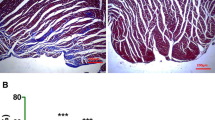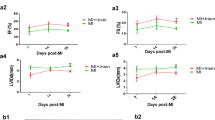Abstract
Angiogenesis plays an important role in myocardial infarction. Apelin and its natural receptor (angiotensin II receptor-like 1, AGTRL-1 or APLNR) induce sprouting of endothelial cells in an autocrine or paracrine manner. The aim of this study is to investigate whether apelin can improve the cardiac function after myocardial infarction by increasing angiogenesis in infarcted myocardium. Left ventricular end-diastolic pressure (LVEDP), left ventricular end systolic pressure (LVESP), left ventricular developed pressure (LVDP), maximal left ventricular pressure development (±LVdp/dtmax), infarct size, and angiogenesis were evaluated to analyze the cardioprotective effects of apelin on ischemic myocardium. Assays of 3-(4,5-dimethylthiazol-2-yl)-2,5-diphenyltetrazolium bromide, 5-bromo-2′-deoxyuridine incorporation, wound healing, transwells, and tube formation were used to detect the effects of apelin on proliferation, migration, and chemotaxis of cardiac microvascular endothelial cells. Fluorescein isothiocyanate-labeled bovine serum albumin penetrating through monolayered cardiac microvascular endothelial cells was measured to evaluate the effects of apelin on permeability of microvascular endothelial cells. In vivo results showed that apelin increased ±LV dp/dtmax and LVESP values, decreased LVEDP values (all p < 0.05), and promoted angiogenesis in rat heart after ligation of the left anterior descending coronary artery. In vitro results showed that apelin dose-dependently enhanced proliferation, migration, chemotaxis, and tube formation, but not permeability of cardiac microvascular endothelial cells. Apelin also increased the expression of vascular endothelial growth factor receptors-2 (VEGFR2) and the endothelium-specific receptor tyrosine kinase (Tie-2) in cardiac microvascular endothelial cells. These results indicated that apelin played a protective role in myocardial infarction through promoting angiogenesis and decreasing permeability of microvascular endothelial cells via upregulating the expression of VEGFR2 and Tie-2 in cardiac microvascular endothelial cells.






Similar content being viewed by others
References
Iribarren C, Phelps BH, Darbinian JA, McCluskey ER, Quesenberry CP, Hytopoulos E, Vogelman JH, Orentreich N (2011) Circulating angiopoietins-1 and -2, angiopoietin receptor Tie-2 and vascular endothelial growth factor-A as biomarkers of acute myocardial infarction: a prospective nested case-control study. BMC Cardiovasc Disord 11:31
Josko J, Gwozdz B, Jedrzejowska-Szypulka H, Hendryk S (2000) Vascular endothelial growth factor (VEGF) and its effect on angiogenesis. Med Sci Monit 6:1047–1052
Carmeliet P, Jain RK (2000) Angiogenesis in cancer and other diseases. Nature 407:249–257
Risau W (1997) Mechanisms of angiogenesis. Nature 386:671–674
Tatemoto K, Hosoya M, Habata Y, Fujii R, Kakegawa T, Zou MX, Kawamata Y, Fukusumi S, Hinuma S, Kitada C, Kurokawa T, Onda H, Fujino M (1998) Isolation and characterization of a novel endogenous peptide ligand for the human APJ receptor. Biochem Biophys Res Commun 251:471–476
Devic E, Rizzoti K, Bodin S, Knibiehler B, Audigier Y (1999) Amino acid sequence and embryonic expression of msr/apj, the mouse homolog of Xenopus X-msr and human APJ. Mech Dev 84:199–203
Kleinz MJ, Davenport AP (2004) Immunocytochemical localization of the endogenous vasoactive peptide apelin to human vascular and endocardial endothelial cells. Regul Pept 118:119–125
Szokodi I, Tavi P, Foldes G, Voutilainen-Myllyla S, Ilves M, Tokola H, Pikkarainen S, Piuhola J, Rysa J, Toth M, Ruskoaho H (2002) Apelin, the novel endogenous ligand of the orphan receptor APJ, regulates cardiac contractility. Circ Res 91:434–440
Ronkainen VP, Ronkainen JJ, Hanninen SL, Leskinen H, Ruas JL, Pereira T, Poellinger L, Vuolteenaho O, Tavi P (2007) Hypoxia inducible factor regulates the cardiac expression and secretion of apelin. FASEB J 21:1821–1830
Cox CM, D’Agostino SL, Miller MK, Heimark RL, Krieg PA (2006) Apelin, the ligand for the endothelial G-protein-coupled receptor, APJ, is a potent angiogenic factor required for normal vascular development of the frog embryo. Dev Biol 296:177–189
Li F, Li L, Qin X, Pan W, Feng F, Chen F, Zhu B, Liao D, Tanowitz H, Albanese C, Chen L (2008) Apelin-induced vascular smooth muscle cell proliferation: the regulation of cyclin D1. Front Biosci 13:3786–3792
Kasai A, Shintani N, Oda M, Kakuda M, Hashimoto H, Matsuda T, Hinuma S, Baba A (2004) Apelin is a novel angiogenic factor in retinal endothelial cells. Biochem Biophys Res Commun 325:395–400
Carmeliet P (2000) Mechanisms of angiogenesis and arteriogenesis. Nat Med 6:389–395
Zeng XJ, Zhang LK, Wang HX, Lu LQ, Ma LQ, Tang CS (2009) Apelin protects heart against ischemia/reperfusion injury in rat. Peptides 30:1144–1152
Jia YX, Pan CS, Zhang J, Geng B, Zhao J, Gerns H, Yang J, Chang JK, Tang CS, Qi YF (2006) Apelin protects myocardial injury induced by isoproterenol in rats. Regul Pept 133:147–154
Kleinz MJ, Baxter GF (2008) Apelin reduces myocardial reperfusion injury independently of PI3K/Akt and P70S6 kinase. Regul Pept 146:271–277
Simpkin JC, Yellon DM, Davidson SM, Lim SY, Wynne AM, Smith CC (2007) Apelin-13 and apelin-36 exhibit direct cardioprotective activity against ischemia-reperfusion injury. Basic Res Cardiol 102:518–528
Smith CC, Mocanu MM, Bowen J, Wynne AM, Simpkin JC, Dixon RA, Cooper MB, Yellon DM (2007) Temporal changes in myocardial salvage kinases during reperfusion following ischemia: studies involving the cardioprotective adipocytokine apelin. Cardiovasc Drugs Ther 21:409–414
Petrova TV, Makinen T, Alitalo K (1999) Signaling via vascular endothelial growth factor receptors. Exp Cell Res 253:117–130
Davis S, Aldrich TH, Jones PF, Acheson A, Compton DL, Jain V, Ryan TE, Bruno J, Radziejewski C, Maisonpierre PC, Yancopoulos GD (1996) Isolation of angiopoietin-1, a ligand for the TIE2 receptor, by secretion-trap expression cloning. Cell 87:1161–1169
Dumont DJ, Gradwohl G, Fong GH, Puri MC, Gertsenstein M, Auerbach A, Breitman ML (1994) Dominant-negative and targeted null mutations in the endothelial receptor tyrosine kinase, tek, reveal a critical role in vasculogenesis of the embryo. Genes Dev 8:1897–1909
Suri C, Jones PF, Patan S, Bartunkova S, Maisonpierre PC, Davis S, Sato TN, Yancopoulos GD (1996) Requisite role of angiopoietin-1, a ligand for the TIE2 receptor, during embryonic angiogenesis. Cell 87:1171–1180
Yu GG, Zeng XJ, Wang HX, Lu LQ, Zheng SP, Ma LQ, Chang J, Wang J, Zhang DM, Du FH, Zhang LK (2011) Cytochrome P450 2J3/epoxyeicosatrienoic acids mediate the cardioprotection induced by ischaemic post-conditioning, but not preconditioning, in the rat. Clin Exp Pharmacol Physiol 38:63–70
Yang JJ, Liu ZQ, Zhang JM, Wang HB, Hu SY, Liu JF, Wang CY, Chen YD (2013) Real-time tracking of adipose tissue-derived stem cells with injectable scaffolds in the infarcted heart. Heart Vessels 28:385–396
Pfeffer JM, Pfeffer MA, Fletcher PJ, Braunwald E (1991) Progressive ventricular remodeling in rat with myocardial infarction. Am J Physiol 260:H1406–H1414
Yang JP, Liu HJ, Liu XF (2010) VEGF promotes angiogenesis and functional recovery in stroke rats. J Invest Surg 23:149–155
Moccia F, Baruffi S, Spaggiari S, Coltrini D, Berra-Romani R, Signorelli S, Castelli L, Taglietti V, Tanzi F (2001) P2y1 and P2y2 receptor-operated Ca2+ signals in primary cultures of cardiac microvascular endothelial cells. Microvasc Res 61:240–252
Nishida M, Carley WW, Gerritsen ME, Ellingsen O, Kelly RA, Smith TW (1993) Isolation and characterization of human and rat cardiac microvascular endothelial cells. Am J Physiol 264:H639–H652
Zeng R, Chen YC, Zeng Z, Liu XX, Liu R, Qiang O, Li X (2012) Inhibition of mini-TyrRS-induced angiogenesis response in endothelial cells by VE-cadherin-dependent mini-TrpRS. Heart Vessels 27:193–201
Yancopoulos GD, Davis S, Gale NW, Rudge JS, Wiegand SJ, Holash J (2000) Vascular-specific growth factors and blood vessel formation. Nature 407:242–248
Li ZD, Bork JP, Krueger B, Patsenker E, Schulze-Krebs A, Hahn EG, Schuppan D (2005) VEGF induces proliferation, migration, and TGF-beta1 expression in mouse glomerular endothelial cells via mitogen-activated protein kinase and phosphatidylinositol 3-kinase. Biochem Biophys Res Commun 334:1049–1060
Giurdanella G, Motta C, Muriana S, Arena V, Anfuso CD, Lupo G, Alberghina M (2011) Cytosolic and calcium-independent phospholipase A(2) mediate glioma-enhanced proangiogenic activity of brain endothelial cells. Microvasc Res 81:1–17
Fox SB, Leek RD, Weekes MP, Whitehouse RM, Gatter KC, Harris AL (1995) Quantitation and prognostic value of breast cancer angiogenesis: comparison of microvessel density, Chalkley count, and computer image analysis. J Pathol 177:275–283
Van Nieuw Amerongen GP, Van Hinsbergh VW (1999) Determination of the endothelial barrier function in vitro. Methods Mol Biol 96:183–189
Magrane J, Christensen RA, Rosen KM, Veereshwarayya V, Querfurth HW (2006) Dissociation of ERK and Akt signaling in endothelial cell angiogenic responses to beta-amyloid. Exp Cell Res 312:996–1010
Kidoya H, Naito H, Takakura N (2010) Apelin induces enlarged and nonleaky blood vessels for functional recovery from ischemia. Blood 115:3166–3174
Kadoglou NP, Lampropoulos S, Kapelouzou A, Gkontopoulos A, Theofilogiannakos EK, Fotiadis G, Kottas G (2010) Serum levels of apelin and ghrelin in patients with acute coronary syndromes and established coronary artery disease—KOZANI Study. Transl Res 155:238–246
Rastaldo R, Cappello S, Folino A, Berta GN, Sprio AE, Losano G, Samaja M, Pagliaro P (2011) Apelin-13 limits infarct size and improves cardiac postischemic mechanical recovery only if given after ischemia. Am J Physiol Heart Circ Physiol 300:H2308–H2315
Kjekshus J (1987) Nitrates in acute myocardial infarction. Drugs 33(Suppl 4):140–146
Segers VF, Lee RT (2010) Protein therapeutics for cardiac regeneration after myocardial infarction. J Cardiovasc Transl Res 3:469–477
Mehlhorn U, Geissler HJ, Laine GA, Allen SJ (2001) Myocardial fluid balance. Eur J Cardiothorac Surg 20:1220–1230
Frangogiannis NG (2012) Regulation of the inflammatory response in cardiac repair. Circ Res 110:159–173
Kasseckert SA, Schafer C, Kluger A, Gligorievski D, Tillmann J, Schluter KD, Noll T, Sauer H, Piper HM, Abdallah Y (2009) Stimulation of cGMP signalling protects coronary endothelium against reperfusion-induced intercellular gap formation. Cardiovasc Res 83:381–387
Thurston G, Rudge JS, Ioffe E, Zhou H, Ross L, Croll SD, Glazer N, Holash J, McDonald DM, Yancopoulos GD (2000) Angiopoietin-1 protects the adult vasculature against plasma leakage. Nat Med 6:460–463
Ward NL, Dumont DJ (2002) The angiopoietins and Tie2/Tek: adding to the complexity of cardiovascular development. Semin Cell Dev Biol 13:19–27
Acknowledgments
This project was supported by the Natural Science Foundation of China (Grant No. 30900573) and Beijing Talents Education Project.
Author information
Authors and Affiliations
Corresponding authors
Additional information
B.-H. Zhang and C.-X. Guo contributed equally to this study.
Rights and permissions
About this article
Cite this article
Zhang, BH., Guo, CX., Wang, HX. et al. Cardioprotective effects of adipokine apelin on myocardial infarction. Heart Vessels 29, 679–689 (2014). https://doi.org/10.1007/s00380-013-0425-z
Received:
Accepted:
Published:
Issue Date:
DOI: https://doi.org/10.1007/s00380-013-0425-z




